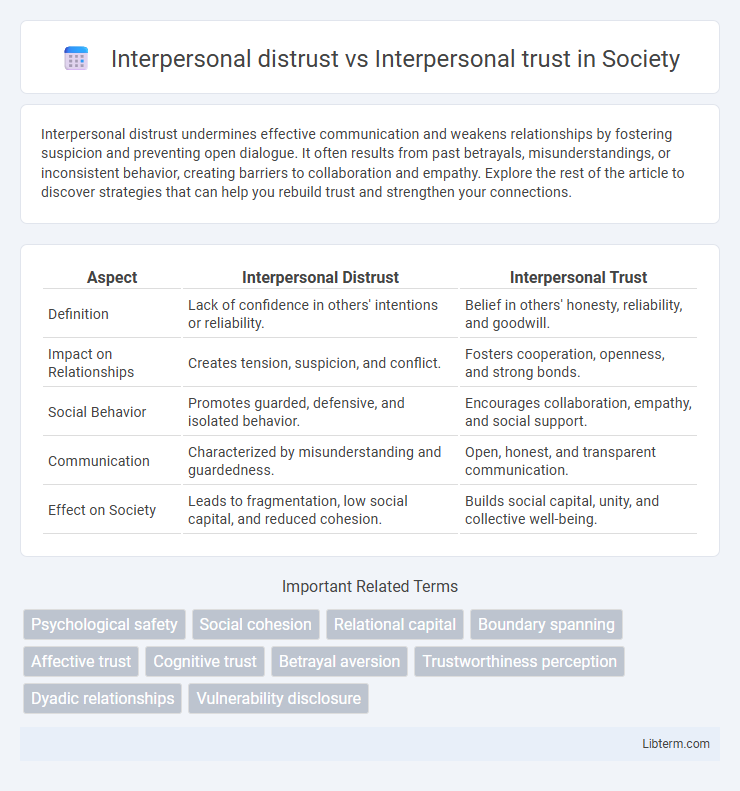Interpersonal distrust undermines effective communication and weakens relationships by fostering suspicion and preventing open dialogue. It often results from past betrayals, misunderstandings, or inconsistent behavior, creating barriers to collaboration and empathy. Explore the rest of the article to discover strategies that can help you rebuild trust and strengthen your connections.
Table of Comparison
| Aspect | Interpersonal Distrust | Interpersonal Trust |
|---|---|---|
| Definition | Lack of confidence in others' intentions or reliability. | Belief in others' honesty, reliability, and goodwill. |
| Impact on Relationships | Creates tension, suspicion, and conflict. | Fosters cooperation, openness, and strong bonds. |
| Social Behavior | Promotes guarded, defensive, and isolated behavior. | Encourages collaboration, empathy, and social support. |
| Communication | Characterized by misunderstanding and guardedness. | Open, honest, and transparent communication. |
| Effect on Society | Leads to fragmentation, low social capital, and reduced cohesion. | Builds social capital, unity, and collective well-being. |
Understanding Interpersonal Trust
Interpersonal trust involves the belief in the reliability, integrity, and benevolence of others, fostering open communication and collaboration. Interpersonal distrust arises from perceived risks, past betrayals, or inconsistent behaviors, leading to guarded interactions and reduced cooperation. Understanding interpersonal trust requires examining factors such as predictability, competence, and emotional connections that influence how trust is built and maintained within relationships.
Defining Interpersonal Distrust
Interpersonal distrust refers to a lack of confidence or suspicion towards others' intentions, often rooted in experiences of betrayal, inconsistency, or perceived threat. It impairs communication, collaboration, and relationship building by fostering skepticism and emotional distance between individuals. Understanding interpersonal distrust is crucial for addressing barriers to trust and promoting healthier social and organizational dynamics.
Key Differences Between Trust and Distrust
Interpersonal trust is characterized by confidence in another person's reliability, honesty, and benevolence, fostering open communication and collaboration, whereas interpersonal distrust involves skepticism, suspicion, and wariness that hinder effective interaction. Trust is built on positive experiences, transparency, and consistent behavior, while distrust often arises from past betrayals, perceived threats, or lack of accountability. The key difference lies in trust enabling risk-taking and vulnerability, whereas distrust triggers defensive behaviors and emotional distance in relationships.
Psychological Foundations of Trust and Distrust
Interpersonal trust is grounded in positive expectations about another's intentions and reliability, often stemming from past experiences, perceived benevolence, and competence. Interpersonal distrust arises from perceived threats, inconsistencies, or past betrayals that activate psychological mechanisms related to vigilance, suspicion, and protective behaviors. The psychological foundations of trust and distrust involve cognitive evaluations, affective responses, and social learning processes that shape how individuals assess risk and predict others' behavior in relationships.
Factors Influencing Trust in Relationships
Factors influencing interpersonal trust in relationships include communication quality, consistency in actions, and perceived empathy. Interpersonal distrust often arises from past betrayals, inconsistent behavior, and lack of transparency, undermining emotional security. Cognitive biases and cultural background also play critical roles in shaping trust levels between individuals.
Causes and Triggers of Distrust
Interpersonal distrust often stems from past experiences of betrayal, inconsistent behavior, and lack of transparency, which erode confidence in others' intentions. Triggers of distrust include miscommunication, unmet expectations, and perceived dishonesty or hidden agendas during interactions. Recognizing these causes is essential for addressing the root of relational conflicts and fostering a culture of trust in social or professional environments.
Effects of Trust on Communication and Collaboration
Interpersonal trust enhances open communication by fostering a safe environment where individuals share ideas and feedback freely, leading to more effective collaboration and problem-solving. In contrast, interpersonal distrust creates barriers, causing guarded interactions, misinterpretations, and reduced information flow that hinder teamwork and productivity. High levels of trust correlate with increased cooperation, innovation, and positive group dynamics, while distrust results in conflict, poor coordination, and diminished organizational performance.
Consequences of Distrust in Interpersonal Dynamics
Interpersonal distrust undermines communication effectiveness, leading to increased misunderstandings and conflicts within relationships. It fosters emotional distance and reduces cooperation, hindering teamwork and collaboration in both personal and professional settings. Persistent distrust also elevates stress levels and decreases overall relationship satisfaction, contributing to long-term relationship deterioration.
Strategies to Build and Restore Trust
Interpersonal trust can be built through consistent transparency, active listening, and demonstrating reliability in actions, fostering an environment where individuals feel secure and valued. To restore trust after interpersonal distrust, implementing open communication, acknowledging mistakes, and offering sincere apologies are crucial for rebuilding credibility and understanding. Establishing clear expectations and maintaining accountability further reinforce trust and mitigate the impact of previous breaches.
Overcoming Barriers to Trust in Personal and Professional Settings
Interpersonal distrust often stems from past betrayals, lack of transparency, and poor communication, creating significant barriers to collaboration and relationship-building in both personal and professional settings. Overcoming these barriers requires consistent honesty, active listening, and demonstrating reliability to rebuild confidence and foster a foundation of interpersonal trust. Establishing clear expectations and addressing concerns openly can accelerate trust restoration and enhance mutual understanding across all relationships.
Interpersonal distrust Infographic

 libterm.com
libterm.com